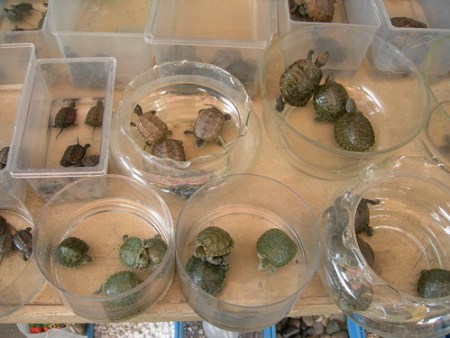Update: Welcome DesiPundit readers! Do visit my other China travel posts: Home Improvement, Shook Lee Ya, 30 April: A Travelogue, and The Joy of Literal Translations.
There were some things in China which were particularly weird or inexplicable. Here are four of the prominent ones.
The Mystery of the Missing Jewellery
Very few Chinese women wear jewellery, or even have their ears pierced. The proportion of women with pierced ears was a lot higher in Shanghai than in places like Qingdao and Dalian, but it was far from being as universal as it is in India or (what little I have seen of) the West.
Interestingly, in the smaller cities like Jinan and Qingdao, the few women who did have earrings were machine operators or airline ground crew, while engineers, air hostesses and office executives had unpierced ears. Twenty to twenty-five women is admittedly a small sample size, but there seemed to be some sort of inverse correlation between jewellery and income.
Hair colouring was much more prevalent, though- and women of all income groups seemed to be colouring their hair- from teenage punks to the lady selling loquats from pole baskets.
My hypothesis: perhaps there is no long-standing tradition of Chinese jewellery for non-aristocrats, and the economic liberalization of the past few years has led to a Western concept of jewllery and ornamentation for everyone being adopted. Low-income women might in fact prefer jewellery, as it allows them to buy tradeable assets; higher-income women would buy financial assets instead (funda courtesy Prof. Vaidyanathan, my first year Investments professor).
The Mystery of the Missing Small Cars
There are some small (by which I mean Zen/ Alto/ Santro) sized cars in China, but they’re pretty rare. The entry level car is pretty much a midsize sedan- the Volkswagen Santana is one of the most popular.
And yet, there are a huge number of people on an entire range of two wheelers: bicycles, electric bicycles, mopeds, scooters and motorcycles. There’s a huge gap between the motorcycles and the Santanas, but Kia (the only make of small car I saw) seems unable to fill it. Even if Kia isn’t able to do it, you would expect some competing auto manufacturer to occupy the niche. But it remains empty.
My hypothesis: Chinese banks are not particularly customer focused, and are reluctant to give car loans to anybody whose income level is not high enough to make a midsize car affordable. Chinese banks would have little or no experience with consumer finance, and without competition from foreign banks, they would have no incentive to create consumer finance products either. That makes life difficult for anybody who wants to upgrade from a motorcycle to a small car.
The Mystery of Shanghai’s Zoning Laws
The mystery is not really about the zoning laws: there don’t seem to be any.
Like this: upscale apartments with little shops on the ground floor.

And a nice restaraunt that’s right next door to a machining shop:

And this three star hotel with factories behind it:

The mystery is not so much that there are no zoning laws, but that despite the lack of zoning laws, land prices remain so low that you can have things like machining workshops on the same road as three star hotels and upscale restaraunts.
Normally, the lack of zoning restrictions adds an option value to real estate. That is, real estate becomes more valuable for the simple reason that you can convert its use to whatever there is more demand for. When there is no restriction on what property is used for, real estate prices should shoot up.
If the guy who runs the workshop is renting the property, the owner would rather kick him out and lease it to someone willing to pay more- such as a three star hotel; and if the guy owns the place, then he’d sell it to the three star hotel himself. So why are all the workshops still around?
Hypothesis 1: The legendary cutting of Chinese red tape exists only for big ticket foreign investors. If you are only a machine shop owner on Zhoujiazui Road, you will find it much more difficult to shut down your workshop and set up a hotel. The option value of converting your land usage is thus very low.
Hypothesis 2: Property rights being what they are in China, the government could sieze your land- whether it is a machine shop or a hotel- for its own purposes at any time. This would not only wipe out the option value, it would also strongly discourage property owners from making capital intensive investments like putting up hotels or apartment blocks.
The Mystery of Condom Pricing
Our hotel in Qingdao provided condoms and sex gel (a sort of herbal preparation which you rub on your genitals prior to intercourse to prevent STDs- there are separate gels for males and females) in the toilet. It made an interesting addition to the usual complement of bathtub foam and shampoo bottles.

What made it different was that the shampoo bottles were free, but the condom and the sex gel packets were 10 yuan each. This doesn’t (heh, pardon the pun) gel. If you aren’t charging anything for shampoo, why charge for condoms? The cost cannot be all that different.
Hypothesis: this is perhaps due to (heh, pardon the other pun) elasticity. (Incidentally, on the topic of bad puns about sexual aids, Durex has a brand in China called Jeans. Perhaps because it’s a comfort fit?) If you have to use a condom, you will probably use it anyway even if it does cost 10 yuan (and especially if you won’t see the charge until you check out). On the other hand, if shampoo were priced, you could just go a day without shampooing. The way in which condoms are used make them much more price inelastic than shampoo and soap, and the hotel simply takes advantage of it.



 Posted by Aadisht
Posted by Aadisht 




















